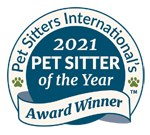As fall gets underway on Long Island, many dog owners are looking forward to long walks with their dogs in the cooler weather. Who doesn’t love admiring the changing leaves and feeling the crisp fall air? At Dan’s Pet Care, our team is also excited to share some autumn walks with your dog! But of course, every season brings unique hazards you should be aware of in order to keep your dog safe. Are you looking forward to some outdoor adventures with your dog this fall? Keep reading to learn more about six potential hazards you could encounter this fall, and what you can do to prevent them.
#1: Darker evenings mean less visibility
As we head into fall, the evening darkness will start to fall a little sooner each day. Unfortunately, this means less visibility when you’re walking your dog after dinner. So how can you combat the risks involved? We’ve got a few recommendations:
Always wear reflective gear, and dress your dog in reflective clothing and accessories. A reflective collar, leash or vest can help ensure that massing motorists can see your dog.
Wear a headlamp when you’re walking your dog in dark conditions.
Always carry a flashlight that’s easy to access quickly if you need it.
#2: Slippery walking surfaces can cause trips and falls
As autumn weather gets underway, a thin layer of fallen leaves often begins to coat the surfaces of paths and sidewalks. This can create slipper conditions, especially when the ground is damp. If your dog slips and falls they could take you down with them—and of course, the reverse is also true. Avoid trips and falls by taking safety precautions, including:
Wear shoes with good traction
Provide your dog with nonslip booties to prevent slips and falls
Stick to paths that offer safer terrain during the fall season
#3: Ticks and fleas may become more active during fall
Ticks and fleas are always a safety concern for your dog. However, they often become more active outdoors during fall. Ticks and fleas aren’t just a source of itching and discomfort for your dog. They can also carry serious diseases that can make your dog very sick, and they can even be fatal. How can you keep your dog safe from fleas and ticks on an autumn walk outdoors? Some important safety measures include:
Apply all flea and tick preventatives as recommended by your veterinarian
Ask your veterinarian about local spots to avoid this season
Give your dog a flea collar to provide added protection on walks (but don’t rely on the flea collar as your whole prevention strategy)
Check your dog carefully for fleas and ticks after walks. They often hide in crevices around your dog’s ears and paws.
#4: Falling leaves and plant parts may endanger your dog
Almost everyone enjoys watching the leaves fall in autumn. But although they’re beautiful, these leaves can also pose a safety hazard for your dog. Like small children, dogs are drawn to leaf piles. They often can’t resist the urge to play or sniff in a pile of autumn leaves. But unfortunately, a leaf pile could be hiding any type of hazard you can think of — from a disease-carrying animal carcass to a sharp object or trash with food items your dog shouldn’t eat. Be sure to keep your dog away from leaf piles wile you’re out and about.
#5: Wild mushrooms can be poisonous to your dog
Wild mushrooms tend to thrive in the cooler weather that fall brings. While most wild mushrooms are safe for your dog to ingest, some are highly toxic and can even be fatal. It’s important to familiarize yourself with local mushroom varieties so you can keep an eye out for hazards. But you should never assume a mushroom is safe for your dog to eat, even if you feel that you’ve identified it as harmless. If you suspect your dog has eaten a mushroom outdoors, contact your veterinarian immediately.
#6: Acorns can create digestive problems for your dog
It’s not uncommon to spot wild acorns on fall walks with your dog. While your dog may be tempted to chew on the, they’re not safe for consumption. Your dog might experience vomiting or diarrhea after eating wild acorns. They can even cause intestinal blockage. Prevent any disasters by avoiding oak trees in the fall as much as possible.
Need a pet care partner this fall?
At Dan’s Pet Care, we’re equipped to handle all of your pet care needs. Does your dog need some extra walks during the upcoming fall season? Our team is ready to help. Contact us today to get started!





